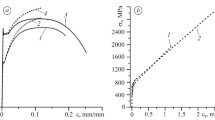Abstract
We describe the methods and results of the experimental investigation of the influence of various modes of thermomechanical preloading on the resistance of nuclear pressure-vessel steels to brittle fracture. We studied specimens of different thickness (25–150 mm) made of the base and weld metals of the vessels of water-moderated, water-cooled nuclear power reactors. The materials under consideration belong to different strength classes. It is shown that the positive effect of thermomechanical preloading is preserved or even strengthened after the subcritical ductile growth of a crack in the process of preloading. We compare the available experimental data with the results of numerical calculations performed by using the Chell model. It is shown that the Chell model fails to explain some experimental data.
Similar content being viewed by others

References
V. V. Pokrovskii, V. T. Troshchenko, V. G. Kaplunenko, et al., ┐A promising method for enhancing the resistance of pressure vessels to brittle fracture,”Int. J. Pres. Ves. Piping,58, 9–24 (1994).
H. Nakamura, H. Kobayashi, T. Kodaira, and H. Nakarawa, “Influence of preloading on the fracture toughness of A533B1 steel,” in: Proc. Intern. Conf. on Fracture (Cannes, March–April 1981), Vol. 3, NII INFORMÉNERGOMASH, Moscow (1985), pp. 27–38.
F. M. Beremin, “Numerical simulation of the effect of thermal prestressing based on the use of the function of damage in the case of tensile fracture,” in: Proc. Intern. Conf. on Fracture (Cannes, March–April 1981), Vol. 3, NII INFORMÉNERGOMASH, Moscow (1985), pp. 27–38.
P. A. S. Reed and J. F. Knott, “An investigation of the warm prestressing (WPS) effect in A533B weld metal,”Fatigue Fract. Eng. Mater. Struct.,15, No. 12, 1251–1270 (1992).
G. G. Chell, J. R. Haigh, and V. Vitek, “A theory of warm prestressing: Experimental validation and implications for elastic-plastic failure criteria,”Int. J. Fract.,17, No. 1, 61–81 (1981).
D. A. Curry, “Micromechanistic approach to the warm prestressing of ferrite steels,”Int. J. Fract.,17, No. 3, 335–342 (1981).
B. T. Timofeev and V. I. Smirnov, “Calculated and experimental estimation of preliminary loading effect at elevated temperatures on the fracture toughness of pressure vessel materials,”Int. J. Press. Ves. Piping,63, 135–140 (1995).
D. Lidbury and P. Birkett, “Effects of warm prestressing on the transition toughness behavior of an A533 grade B class 1 pressure vessel steel,” in: Proc. 21st Symposium on Fracture Mechanics, ASTM STP 1074 (1994), pp. 264–285.
D. K. M. Shum, “Warm prestress effects in fracture-margin assessment of PWRRPVS,” in: K. Kussmaul (ed.), SMiRT-12, Elsevier (1993), pp. 333–338.
GOST 25.506. -85. Strength Analysis and Tests. Methods for Mechanical Testing of Metals. Determination of the Characteristics of Crack Resistance (Fracture Toughness) under Static Loading [in Russian], Izd. Standartov, Moscow (1985).
V. T. Troshchenko, V. V. Pokrovskii, and V. G. Kaplunenko, “Prediction of the crack resistance of heat-resistant steels with regard for the influence of the sizes of specimens. Part 1. Experimental results,”Probl. Prochn., No. 1, 5–27 (1997).
G. P. Karzov, B. Z. Margolin, and V. A. Shvetsova,Physicomechanical Simulation of Fracture Processes [in Russian], Politekhnika, St. Petersburg (1993).
P. Hopkins and G. Jolley, “The significance of crack blunting (stretch zones) in fracture toughness specimens,” in: Proc. ECF-4 Conference, Vol. 4 (1982), pp. 1–7.
S. N. Alturi (editor),Computational Methods in Fracture Mechanics, North-Holland, Amsterdam (1986).
M. Shiratori, T. Miyoshi, and T. Matsushita,Computational Fracture Mechanics [Russian translation], Mir, Moscow (1986).
Additional information
Institute for Problems of Strength, National Academy of Sciences of Ukraine, Kiev, Ukraine. Translated from Problemy Prochnosti, No. 2, pp. 126–138, March–April, 1999.
Rights and permissions
About this article
Cite this article
Pokrovskii, V.V., Ivanchenko, A.G. Influence of the modes of thermomechanical preloading on the resistance of heat-resistant steels to brittle fracture. Strength Mater 31, 200–209 (1999). https://doi.org/10.1007/BF02511110
Received:
Issue Date:
DOI: https://doi.org/10.1007/BF02511110



